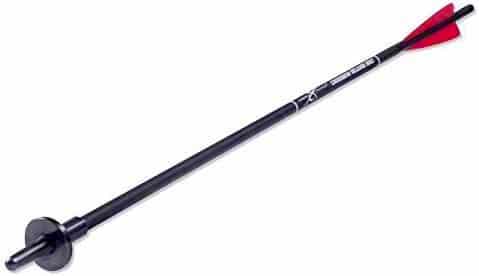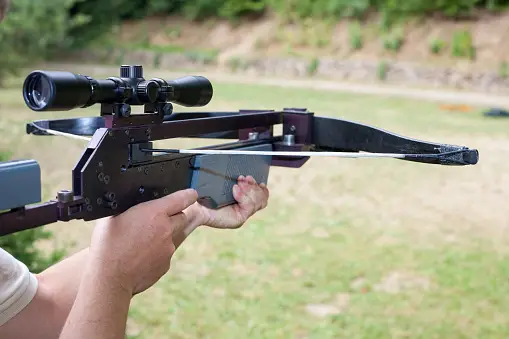Last Updated on May 13, 2023 by Dwayne Easton
The best case scenario is that you have all the time in the world to uncock your crossbow while hunting. Bow hunters know that reality is not always like this.
What do you do with a fully loaded crossbow? It must go somewhere. Presumably safe. Or does it?
You must uncock it!
But how to uncock a crossbow without firing it?
Here are four safe and easy ways to do it.
1. Use A Discharge Bolt

You can shoot your crossbow into the ground using a discharge bolt. This bolt is designed to withstand the damage and prevent your crossboy from getting destroy.
This method has a disadvantage. The discharge bolt can take up space in your quiver which may be limited to three to four bolts at a time. Warning: You must be careful with your shot! It is important to aim several yards ahead of you instead of pointing it straight down from where you are standing, and not hit any rocks or other objects. You will then need to retrieve it.
In some states it is illegal to walk back to your vehicle after legal shooting hours with a cocked crossbow. Biodegradable unloading bolt is what you want to look into. It just gives those people who are forced by law to uncock there bow at their stand site at dark another option to do so.
2. Use A Crossbow Defuser or Decocker
A Crossbow decocker is a device that can be used to decock a crossbow. It is usually shaped like a cross and you load it into your crossbow rail just like you would a bolt. The crossbow rail holds the bowstrings and limbs, so that they don’t lose their energy. The defuser mechanism slows down the bowstring’s and limbs to their precocked positions after you have “fired” the crossbow.
The defuser is an excellent way to silently decock your bow. It is an expensive device yet must have for every hunt.
Crossbow diffusers can be tricky at first. Every model has a slight variation.
Don’t worry, this video shows you how to use a standard crossbow decocker.
3. Use A Crank
Cranks are used to cock your crossbow. However, they can also be used for uncocking. There are many models available, some of which can be integrated into your crossbow, and others that work independently, but they all follow the same principle. They attach to the bowstring and use a rotating lever.
The same principle can be applied in reverse. You can let the energy of your crossbow dissipate by uncocking it with the crank. This allows it to apply a lower force over a longer distance, so that it doesn’t cause damage to the crossbow.
You must ensure that the crank is properly attached to your bowstring before you can use it. After it holds the bowstring, release the trigger to lower the bowstring.
This video shows how to uncock a Ravin crossbow using a crank.
4. Use A Cocking Rope
Cocking ropes can also be used cock your crossbow. They can also be used to decock, but they are much easier than cranks. You simply attach a rope to the bowstring and hold the crossbow with your foot. The bowstring will then be drawn by using enough leverage.
The same procedure can be used to decock a crossbow. Attach the cocking rope to the bowstring, then gently lower it down. This requires precision and strength so please be careful.
Before you use your crossbow, make sure to check the condition of your cocking rope. This is an important part of crossbow maintenance and should be done in order to ensure safe and accurate use.
This video shows you how to uncock your crossbow using a cocking rope.
Why Is It Important To Decock/Uncock A Crossbow?
When cocked, a crossbow can store a lot of energy . It’s similar to carrying a loaded gun around. The difference is even without “ammo”, a cocked crossbow is still dangerous.
Accidentally firing your crossbow could be fatal. You could hurt yourself or the people around you. At the very least, you don’t want to waste your bolt. Even if there isn’t a bolt in your crossbow, all of that energy must go somewhere.
A crossbow that is dry fired will most likely cause damage. It could be internal damage, even if you don’t notice it immediately. Your crossbow could then break completely, sending pieces flying at your face.
One more thing. It is illegal in some states to carry your crossbow while walking around, so it is important to decock it when you aren’t using it.
How to Safely Uncock/Decock a Crossbow
Every Crossbow Designs Are Slightly Different
There are many types of crossbows. Your crossbow design will help you decide which uncocking method works best for you. Some models have safety locks that prevent you from removing the bolt from the rail. It’s a bad idea to unload the crossbow before the safety is released. A crossbow such as this should not be used with a discharge bolt, or crossbow diffuser.
To learn how to uncock each crossbow model, read the crossbow review. The types of bow is also important for example crossbow vs compound bow.
Take A Look At Your Surroundings
Look around before you shoot your crossbow into the ground or a target. You never know who might cross your path.
Even if the bolt isn’t a person, it could be accidentally shot at a tree or rock. This can cause damage to the bolt or send it bouncing away from where you don’t want.
Get In The Habit Of Decocking Your Crossbow
It’s hard to leave your crossbow cocked long enough to cause damage to its limbs, bowstring, and trigger mechanism. Modern models can handle this well enough that you don’t have to keep your crossbow cocked when hunting.
However, it is important to decock your crossbow when not in use. Experts recommend that you decock your crossbow after four hours. However, it is best to not leave your crossbow cocked for more than 24 hours. This could cause damage to the limbs and stretch the string, which can impact accuracy and the range of your crossbow.
NEVER Dry fire a crossbow
Crossbow novices are often tempted just to pull the trigger and grab their bolt. This will not only ruin your crossbow, but it could also cause serious injury to you.
Dry firing a crossbow can cause the energy to go into it, which can cause it to shatter or explode. These fragments could strike you in an area that is vulnerable, such as your eyes, and cause serious injury.
Even if your crossbow doesn’t explode when dry-fired, there will be internal damage. This could lead to it exploding or splintering the next time you use the crossbow, which poses the same risk.
Final Thoughts on How to Uncock a Crossbow
After a hard day of hunting game meat, you returned home yet your crossbow is still cock. You now need to uncock the crossbow.
Crossbow decocking is a good practice for you and everyone safety. Sometimes, it is a legal requirement.
You should use one of these four methods to decock your crossbow correctly after a hunt.

